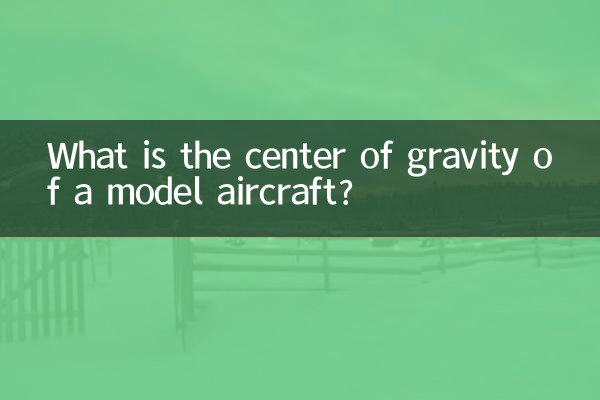What is the center of gravity of a model aircraft: key elements to understand and adjust
The performance and stability of a model aircraft largely depend on the position of its center of gravity. Whether you are a beginner or an experienced player, mastering the principles and adjustment methods of model aircraft center of gravity is the core to improving your flight experience. This article will combine recent hot topics and hot content on the Internet to analyze the definition, importance and practical skills of model aircraft center of gravity in the form of structured data.
1. Definition and importance of model aircraft center of gravity

The Center of Gravity (CG) of a model aircraft refers to the virtual point where the weight of each part of the model aircraft is balanced. It is usually located about 25%-30% behind the leading edge of the wing. The center of gravity directly affects the pitch stability of the aircraft:
| Center of gravity position | flight performance | Risk warning |
|---|---|---|
| too forward | The nose of the aircraft sinks and the rudder needs to be continuously raised. | High power consumption and easy to stall |
| too far back | The machine head is sensitive and difficult to control | May cause spin or roll |
| ideal location | Smooth glide and responsiveness | Need to be confirmed through test flight fine-tuning |
2. Recent cases of popular aircraft model center of gravity adjustments (data in the past 10 days)
Through analysis of aircraft model forums and social media, the following are typical problems and solutions that are hotly discussed by users:
| Popular models | Frequently asked questions | Recommended adjustment methods |
|---|---|---|
| FPV racing drone | Rear-mounted battery causes excessive rolling | Move the battery forward or add counterweights |
| Fixed wing training aircraft | Automatically tilt up after takeoff | Check the machine head counterweight and move it forward 1-2cm |
| 3D Stunt Helicopter | Unstable hover | Adjust the balance between battery and ESC positions |
3. 4 practical steps for adjusting the center of gravity of model aircraft
1.Theoretical calculation: Refer to the model manual or formula to calculate the initial center of gravity position (usually 25%-35% of the average aerodynamic chord length).
2.finger test: Place the aircraft horizontally on your fingertips, observe whether the nose or tail of the aircraft droops naturally, and adjust it to a balanced state.
3.Test flight verification: Keep a low altitude during the first flight, test the dive and pull-up response speed, and make emergency landing adjustments if necessary.
4.Accessories optimization: Use the removable battery compartment, lead weights or 3D printed brackets for fine adjustments.
4. The impact of new industry technologies on focus management
Recent hot spots show that two technologies are changing the traditional focus adjustment method:
| Technical name | Application advantages | Representative products |
|---|---|---|
| electronic trim system | Automatically fine-tune the center of gravity during flight | FrSky S8R receiver |
| Modular design | Quickly swap components to change balance | DJI Avata adjustable stand |
5. Safety instructions and common misunderstandings
•Myth 1: "The further back the center of gravity is, the better the maneuverability" - excessive rear positioning will lead to uncontrollable rotation.
•Myth 2: "The center of gravity ratio of all aircraft models is the same" - special layouts such as swept wings and delta wings need to be calculated separately.
•Safety tips: The center of gravity must be rechecked every time the battery or propeller is replaced, and 5% front redundancy must be reserved in windy weather.
Conclusion:The center of gravity of model aircraft is a key node connecting physics and practical art. Through systematic adjustments and the application of new technologies, players can significantly improve flight performance. It is recommended to collect the structured data table in this article as a quick reference guide, and regularly pay attention to the focus optimization case sharing of the aircraft model community.

check the details

check the details